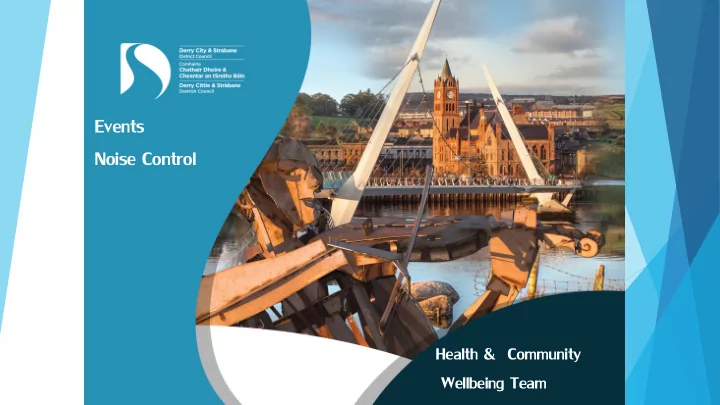

Events Noise Control Health & Community Wellbeing Team
Concerts tattoos INDOOR Marquees OUTDOOR
LEGISLATION Clean Neighbourhoods and Environment Act (NI) 2011 Section 63: “statutory nuisances” (i) noise emitted from premises so as to be prejudicial to health or a nuisance Section 65 —(1) where a district council is satisfied that a statutory nuisance exists , or is likely to occur or recur , in the district of the council, the district council shall serve a notice (“an abatement notice”) imposing all or any of the following: • requiring the abatement of the nuisance or prohibiting or restricting its occurrence or recurrence , • requiring the execution of such works , and the taking of such other steps , as may be necessary for any of those purposes, and the notice shall specify the time or times within which the requirements of the notice are to be complied with. A person who commits an offence… shall be liable on summary conviction to a fine not exceeding £20,000.
Decibels (dB)
5 minute Measurement at Top of Browning Drive taken during city-side concert dB(A) Time 63 Hz Leq (blue) – 68.2 125 Hz (pink) – 62.4 Leq (Average) (green) - 53.8
Code of Practice: Environmental Noise Control at Concerts THE NOISE COUNCIL
The following steps are recommended by Environmental Health: Before the event: • Contact an environmental health officer to discuss any concerns/requirement for Noise Management Plan (NMP) to control noise. • NMP: event location/type music provision/ nearest housing/ times/ no. of days/ number of patrons/acoustic consultancy? • Leaflet drop/write to local residents informing them of the event – when/where/start and finish times/ organiser’s phone number so that residents can call if they are disturbed by event noise.
Before the event: • Plan the layout of the site if outdoors, i.e. move noisy activities away from the most sensitive location. • Indoor events: keep doors and windows closed where possible. • Prepare Noise Monitoring Forms (if necessary)
Example Noise Monitoring Form Event name: Applicant:……………………………. Name of responsible person ………. Sound monitoring Instructions…………. 1. Regular observations (at the start of the event and then at the start of each new performance with each consecutive period of 60 minutes until the end of the event) shall be undertake by a responsible person at the following locations: a)……………………………………………………….. b)………………………………………………………… c)……………………………………………………………. (See map attached) 2. A log of each observation shall be kept. The log shall include the following details: A – Inaudible (no noise can be heard) B – Detectible (when music is heard during lulls in traffic movement) C – Noticeable (when music is heard above traffic/other background noise) D – High (when elements of the music are identifiable at any time, such as lyrics or words spoken/sung, guitar noise, drums or other instruments through the PA are identifiable Note: if C or D is recorded, the sound engineer/licence holder must be contacted immediately to have the sound level reduced. You must then return to the monitoring location where C or D was recorded to reassess whether the reduction is sound level is enough to achieve A or B. If it is not then the sound engineer/licence holder must be approached again for a further reduction in sound levels. This process must be repeated until an acceptable noise level (i.e. A or B) is reached.
During and after the event • Nominate person to patrol at nearby houses during the event to complete the Noise Monitoring Forms - check the noise levels. If music is likely to cause nuisance - reduce volume. • Advise people leaving the event, especially late at night, to do so quietly and not unreasonably disturb residents in the neighbourhood. • Position speakers so they point into the building, or if outdoor event, away from any noise sensitive premises. • Ensure windows and doors kept shut. Lower volume towards the end of the event. After 11:00pm, music should not be audible inside a residential property, with windows open in a typical manner for ventilation.” Ideally music should not continue past 11:00pm.
Indoor Mitigation - Structure • Upgraded glazing – unopenable • Upgraded roof – suspended heavy ceiling, no opening • Acoustic silencers on ventilation • Lobby buffer between entertainment spaces and external areas • Upgraded doors with good seals • No external speakers • Place quieter areas of building towards residents - buffer
Mitigation - Management • Not allow noise limiters to be bypassed • No external PA systems • Not allow lobby doors to be propped open – poor ventilation • Not allow windows to be opened • Not allow rowdy external behaviour • Manage crowd numbers
Mitigation – Noise Limiters Traffic Light – microphone feed back, cuts power Compression – keeps noise at set level but not allow above Do not allow noise limiters to be by-passed!
Useful Links Institute of Acoustics www.ioa.org.uk/ Association of Noise Consultants www.association-of-noise-consultants.co.uk/ DAERA – Noise www.daera-ni.gov.uk/articles/noise Code of Practice on Environmental Noise Control at Concerts https://www.gov.je/.../ID%20Code%20of%20Practice%20on%20Env ironmental%20N... Derry City and Strabane District Council www.derrystrabane.com Thank you
Recommend
More recommend